"Do You Care What Airline We Take?" Said nobody ever.
Airlines are a great example of how strategy and branding can drive business success.
They are all buying and utilizing the same products from Boeing, Airbus, Rolls Royce, etc.
The only differences between the major airlines are simple branding and strategy choices like territories, maintenance, brand position, offerings, capabilities, etc.
Below I’m going to callout a few brands by the criteria above to help me explore strategy in the marketplace:
Price - $$$
Comfort - 1st Class, Comfort+, Economy w/ seat selection, Economy
Entertainment - Live TV and seatback entertainment on each seat
Free Amenities - Headphones, Beverage & Snack, Entertainment, WiFi
Territory - ATL, East Coast, MSP, and LAX
Service - Free Carry On & Personal Item, Beverage & Snack service included
Brand Position - Premium
Price - $
Comfort - Big Front Seat, Economy w/ seat selection, Economy
Entertainment - BYOD (Device)
Free Amenities - Paid WiFi
Territory - Hubs on East Coast, Sprawling Westward in Chicago, Las Vegas, and Dallas
Service - Paid Snack & Beverage Service
Brand Position - Ultra Low Cost
Price - $$
Comfort - Economy only
Entertainment - WiFi, BYOD (Device)
Free Amenities - Wifi, Drink, Snack
Territory - Large hubs on each coast, Chicago and Denver
Service - Free Carry On & Personal Item, Snack and Beverage service included
Brand Position - Logistics
We can identify each brand by its offerings and logo. If you fly a lot, you can probably identify each airline just by their offerings.
There are plenty of viable strategies to succeed in the marketplace.
Each company operates with a different strategy. Each company carries thousands of flights a month.
But That Can’t Be All It Is
The only differences between these flight carriers can’t be the bullet points above. That would be far too easy; and the airline industry has a reputation for being cutthroat.
When you look at the logo of each of these flight carriers, you already have a deeply rooted connection for and against them.
Each time you fly you’re not only judging your experience, you’re also judging the person arguing with the gate attendant while you walk to get lunch. “I wouldn’t wanna be that guy” you whisper to your travel buddy. You take note of the airliner operating the gate.
So why do Delta, Spirit, and Southwest post profits historically while other airliners can’t figure it out?
These businesses all operate with different strategies. But, there’s one overarching commonality, expectations.
In their advertising, they show what it’s like to ride with them. Of course, the affects are dramatized, as good advertising does.
The image was part of a campaign by Hales picturing Delta’s Cabin Service.
The image captures so many of their amenities without a single word of copy. The seatback experience, the clean cabins, the roomy windows and overhead bins.
It doesn’t take long to realize who’s paying for the billboard below. You don’t even need to see the logo to know, for the same reasons you knew which airline I was referencing above when I showed a yellow plane with no logo.
Spirit doesn’t have a proper ‘logo’ - another place they cheaped out. But props to them for “Owning a Color.”
Don’t F*ck It Up
Some of the main reasons we travel are for work or with/ for family. Naturally, there is a lot at stake. Factor in the hundreds or thousands of miles you plan to travel that day and things can get stressful. The expectations you set for us better be spot on.
How Do Airlines Find a Position?
First, it’s important to realize that they all have a unique offering. No airlines are trying to offer the same products in the same way.
Next, they all stand firmly on their position in all of their operations. It’s not just the marketing team that offers a premium proposition, and it’s not just the maintenance team going above and beyond. From top to bottom Delta’s employees understand what sets them apart and why customers decided to fly Delta.
They realize that they are part of the charade, without their participation the curtain peels back and the paychecks slow down.
A good strategy is easy for employees to understand. You can only expect employees to get behind your strategy if they understand it.
When you have a good strategy in place this makes your marketing claims and messages much more effective - because they are actually true.
A deep rooted loyalty
Airlines do a great job at harboring brand loyalty.
Strategic territories, Skymiles, great experiences, avoiding bad experiences, offers or discounts, etc. are all reasons customers might consistently choose one airline over another.
Generalizing the Learnings
The airline industry is a great place to look for successful differentiation strategies because the margins are thin and they all start with the same shell of a product.
What do airlines do that we should do?
Obsess over customers
Lean into a position and strategy
Differentiate where you can
How can you make the same product look different? Every airliners Boeing 787s looks different inside and out.
How can you add value? By increasing productivity with logistics? By reducing availability/ increasing ammeneites?
How is your offering different than direct competition? Show that in your marketing
PS: What makes certain airlines great is their ability to consistently stand out in a busy market. When you see a glimpse of their logo, you notice. And you start to think about every good or bad experience you’ve had with them.









Hi David, this was an interesting read
Keep it going bro 😍
I have a bit of background experience in marketing and branding too so maybe we might even have a few ideas to exchange with each other